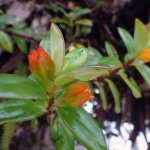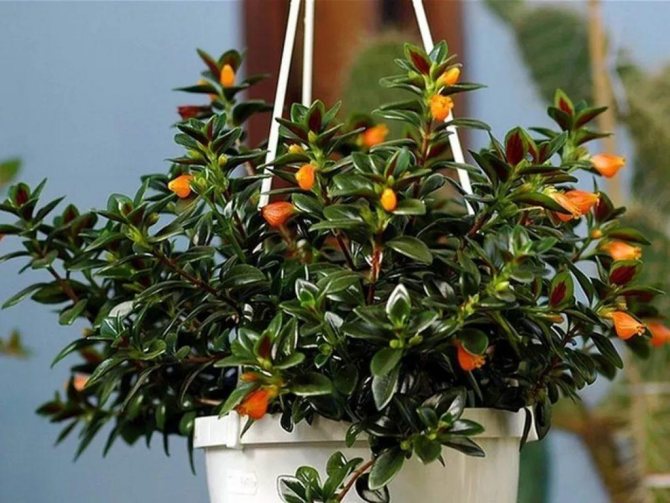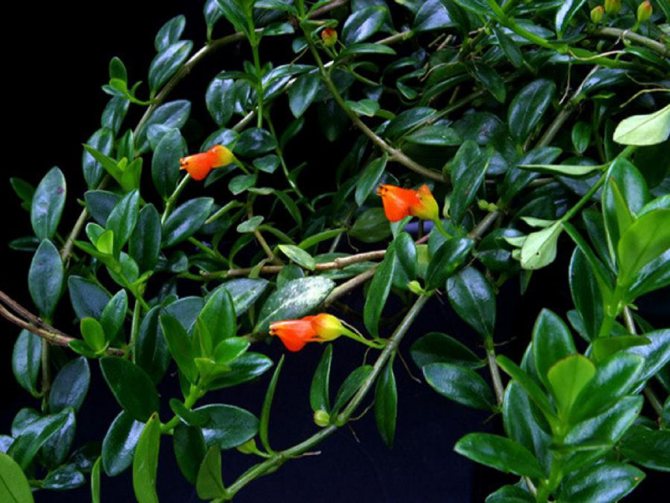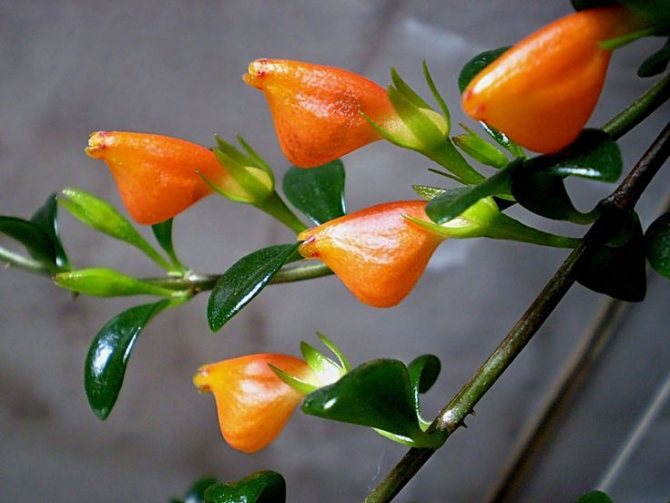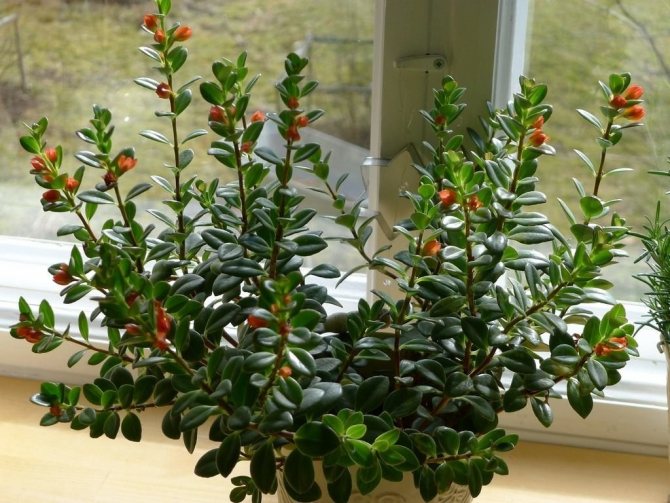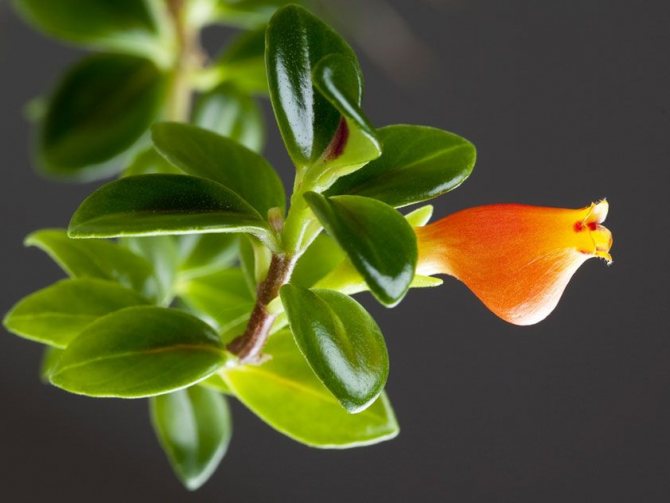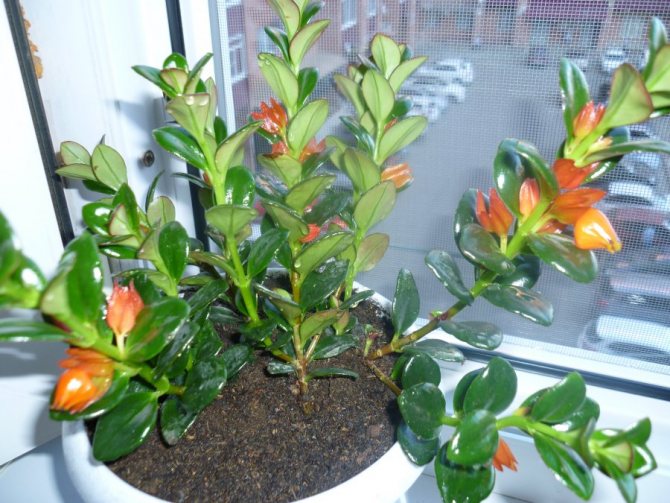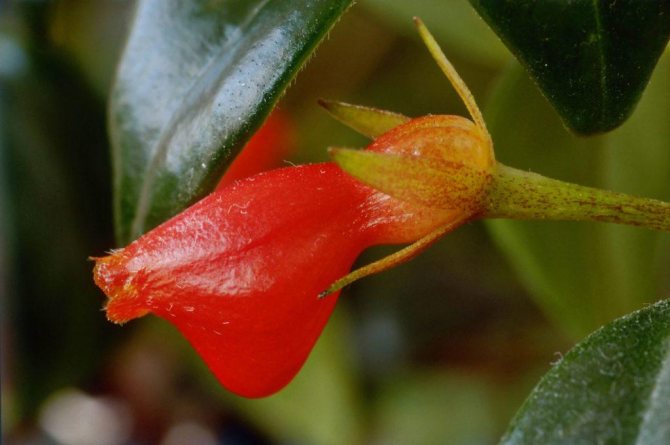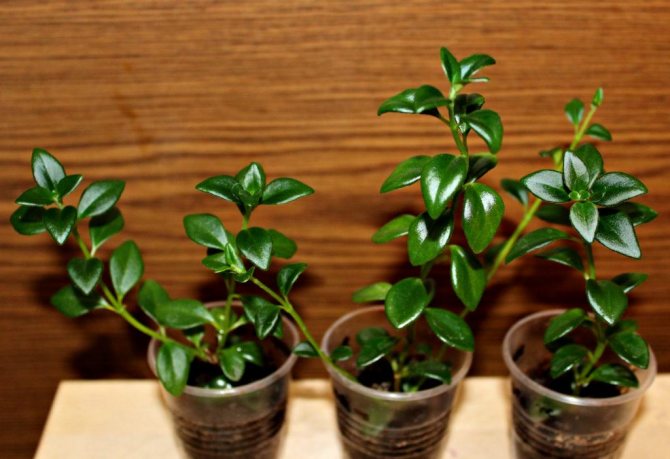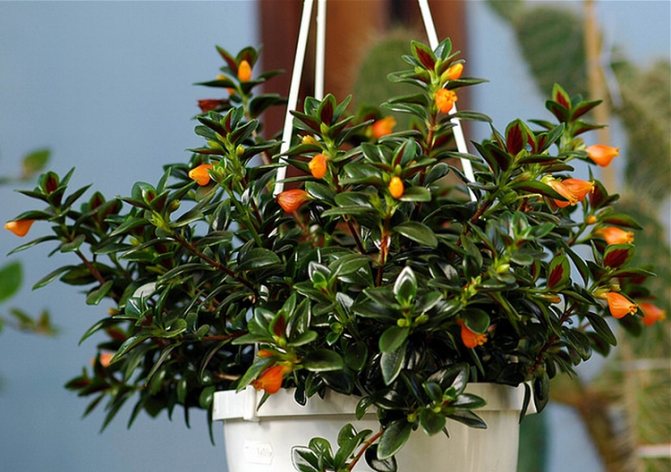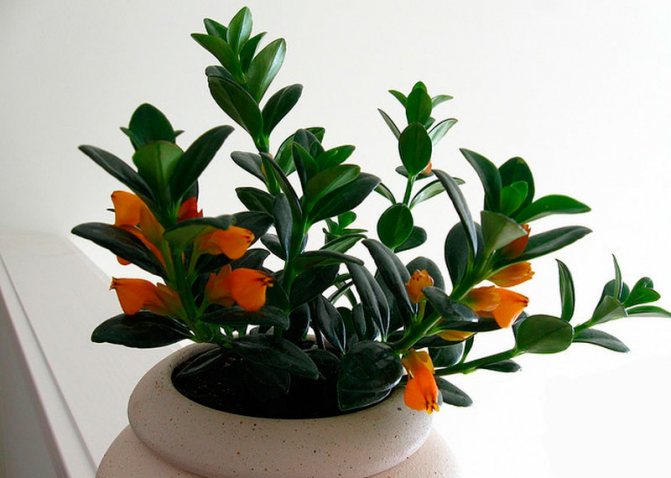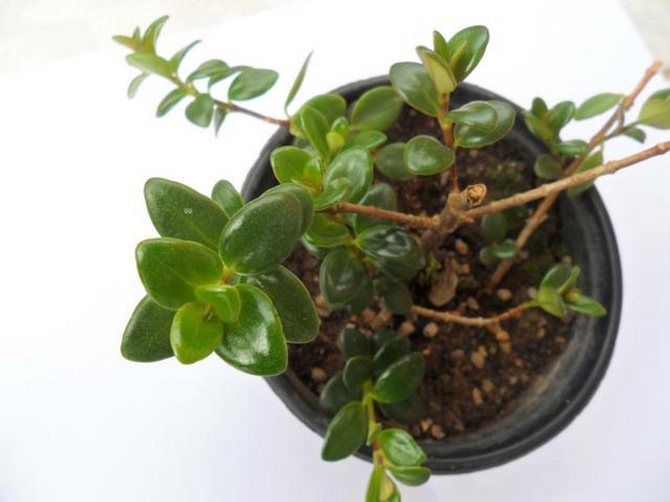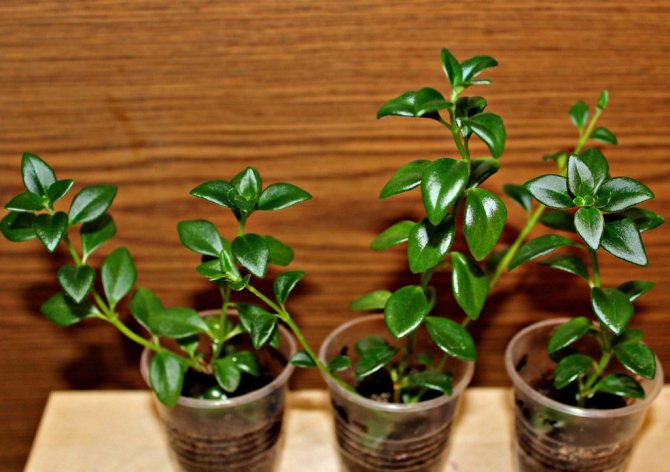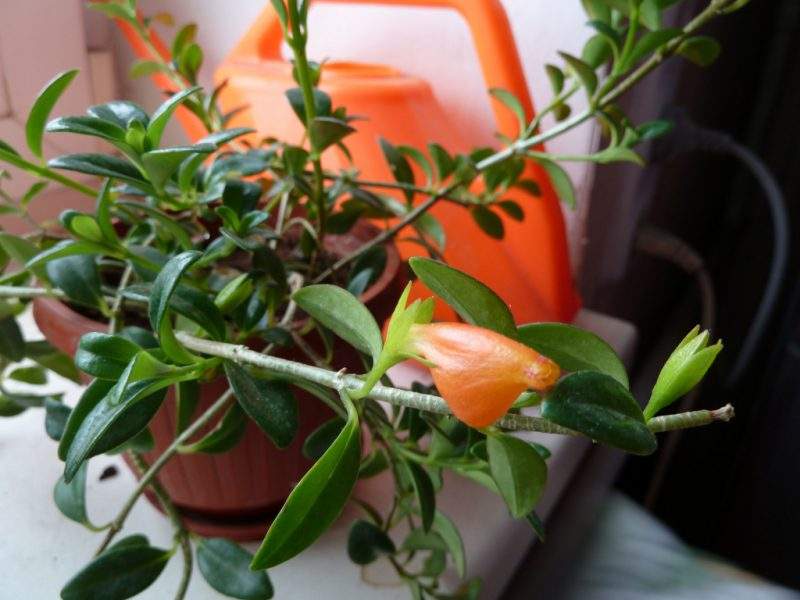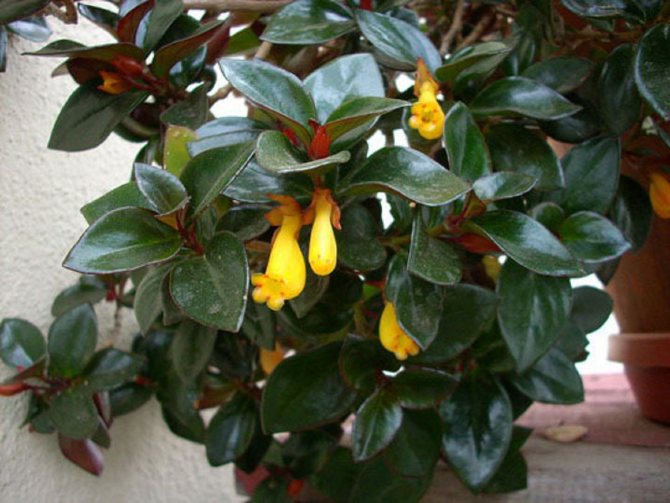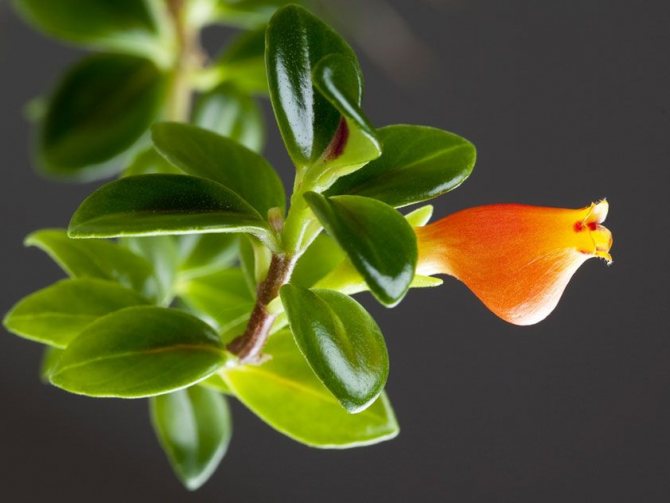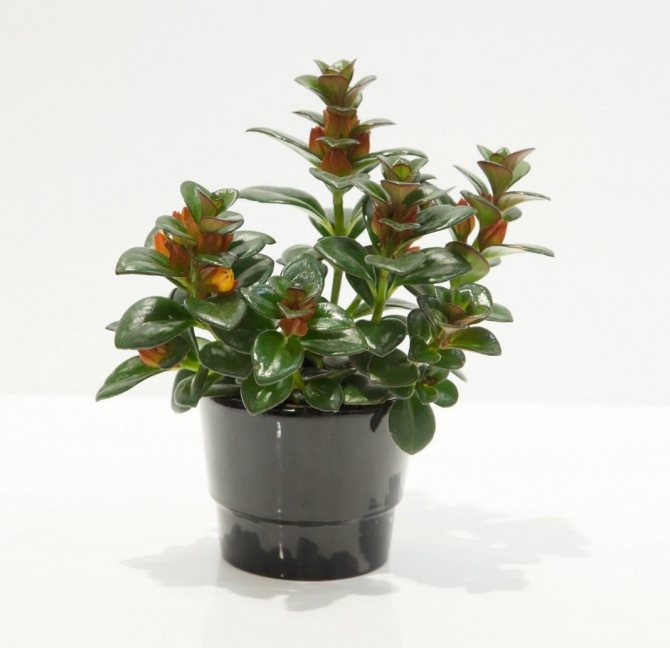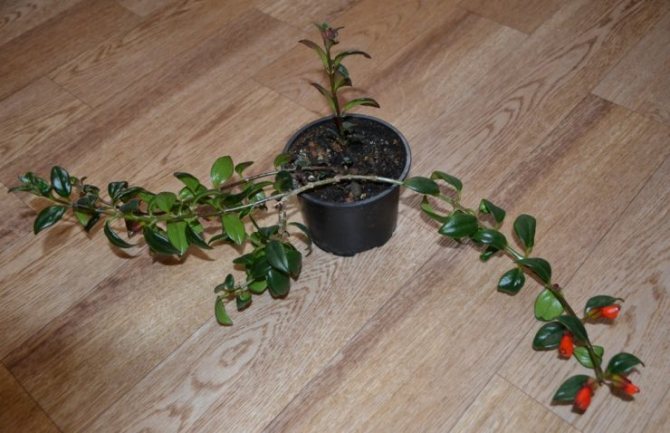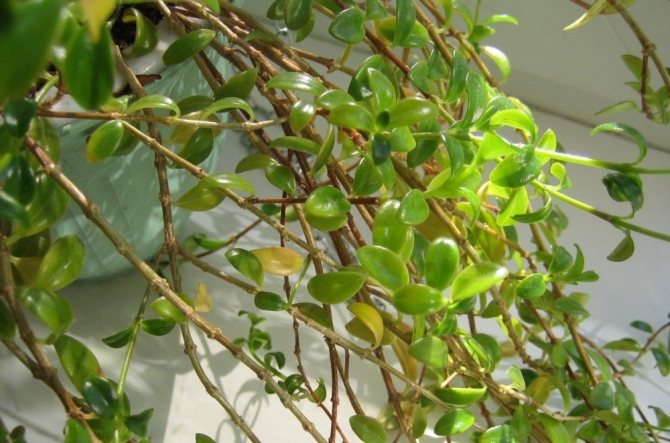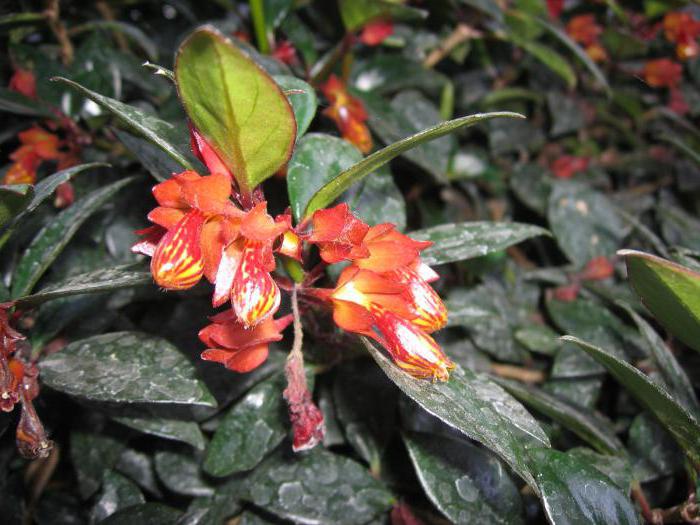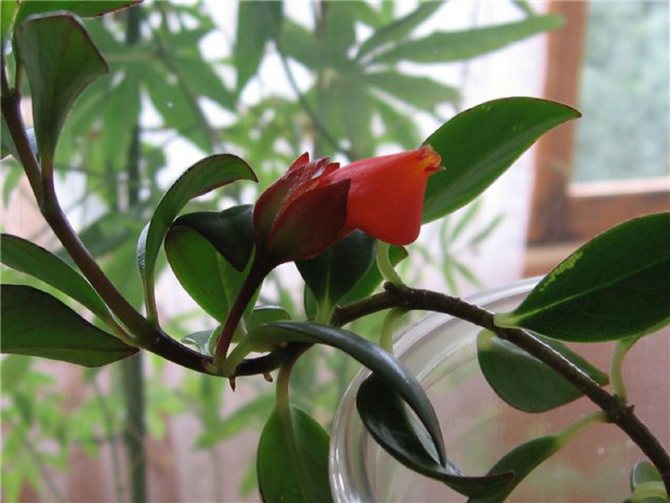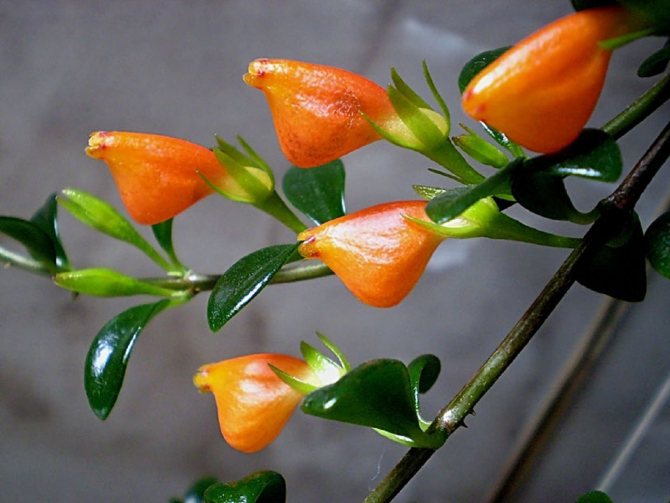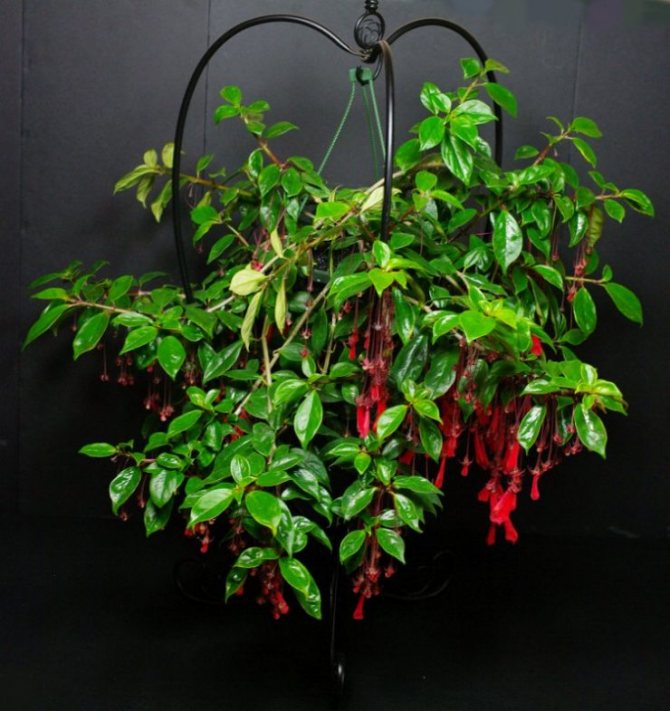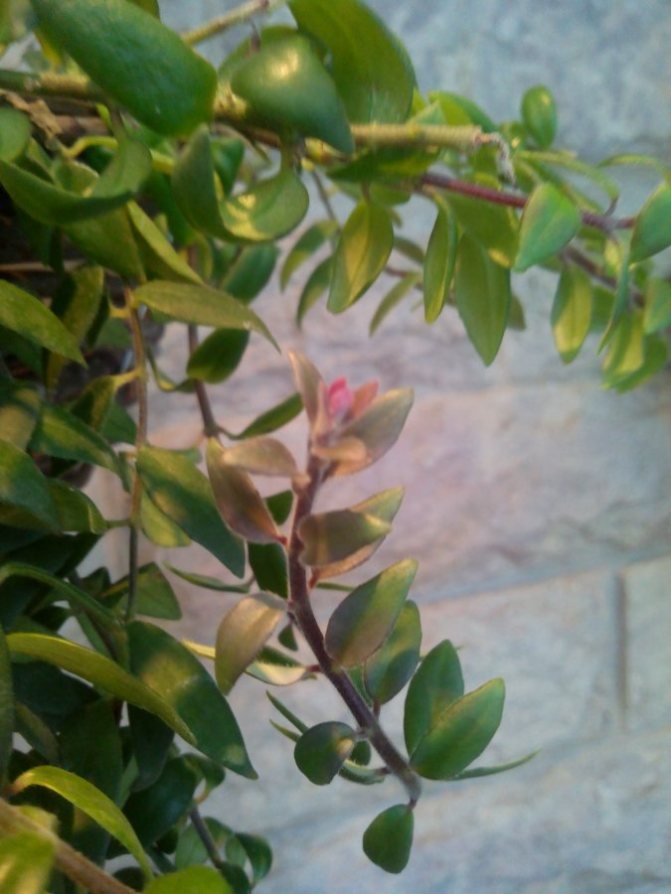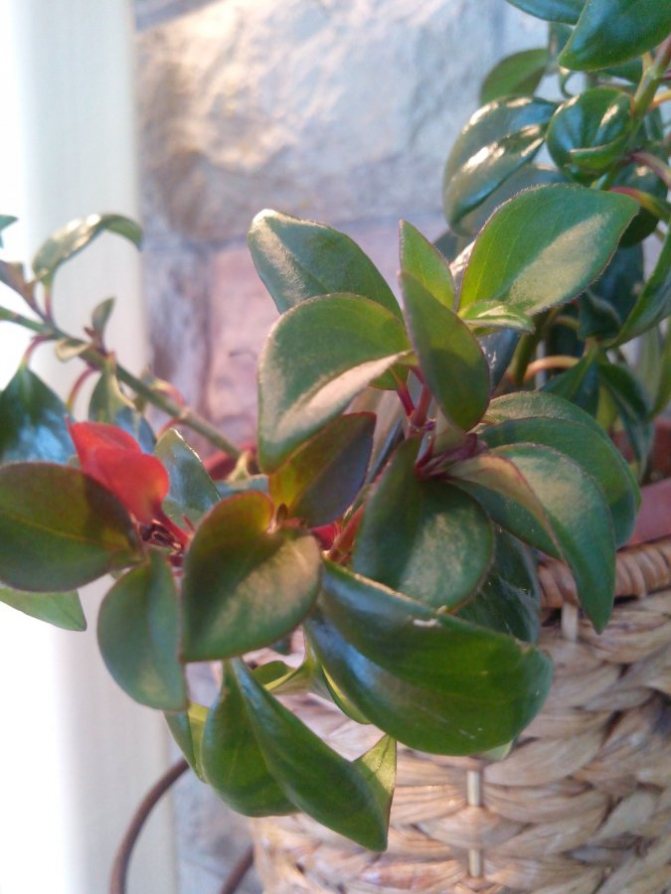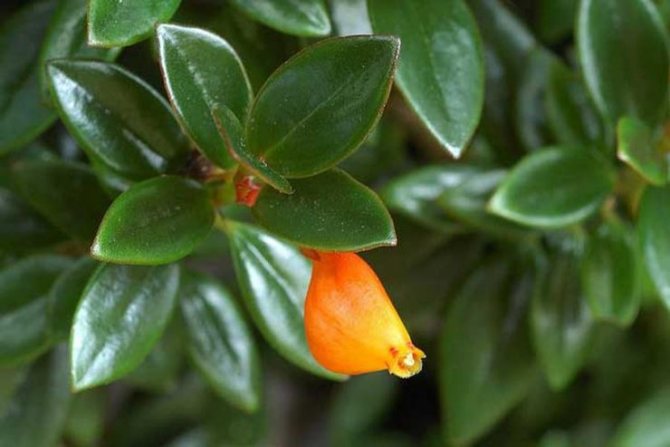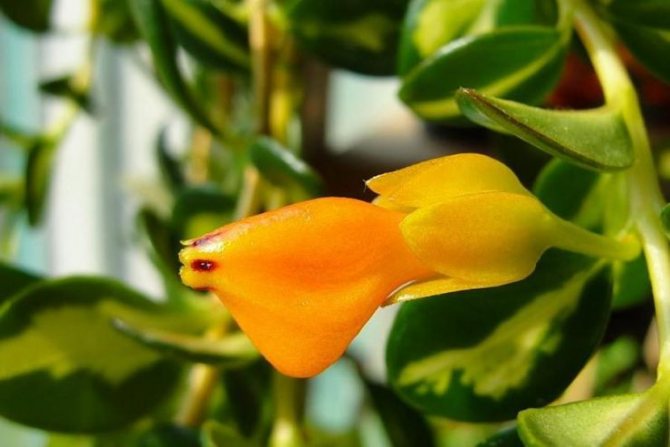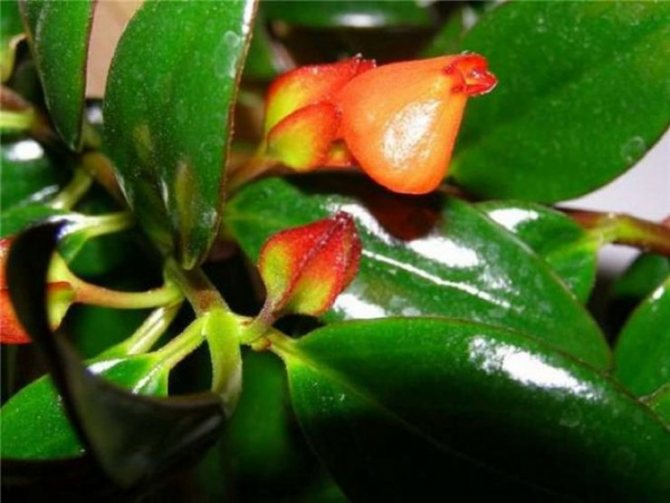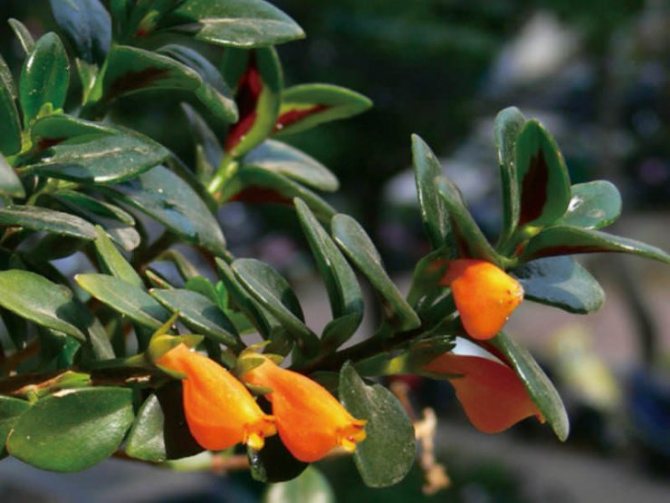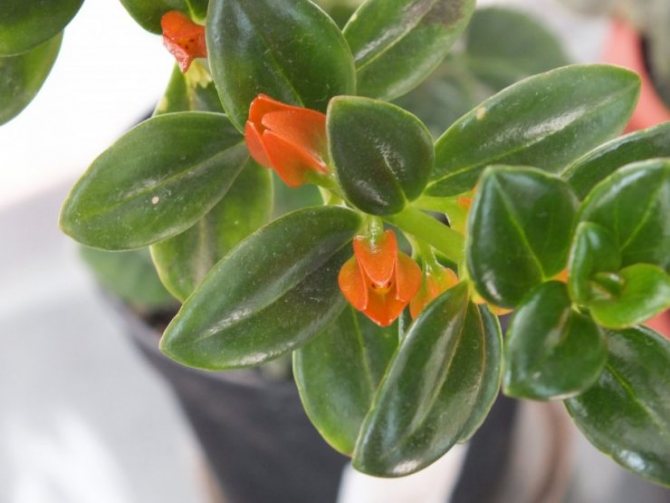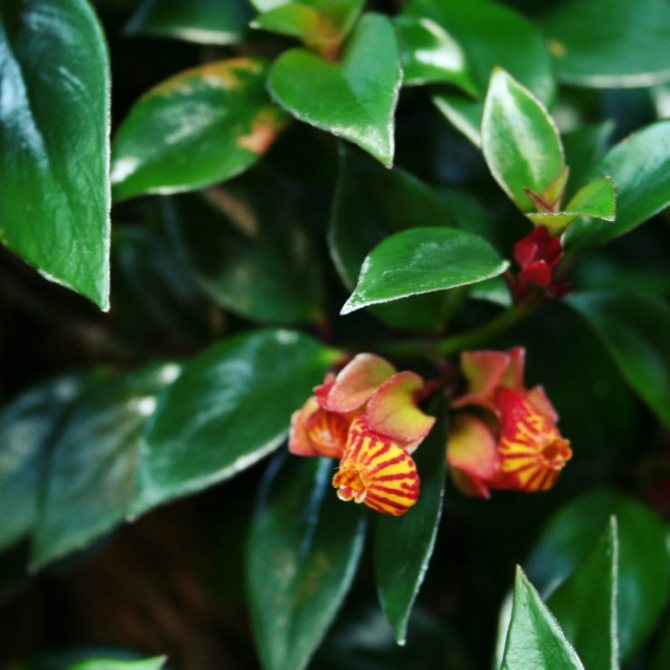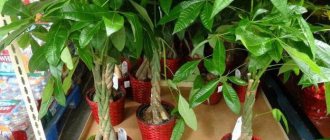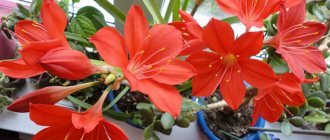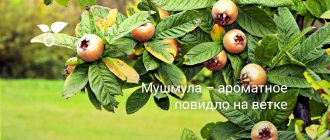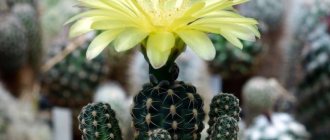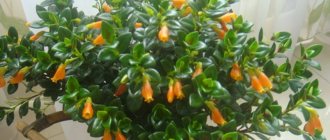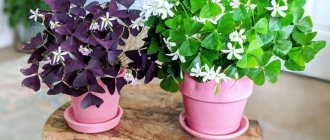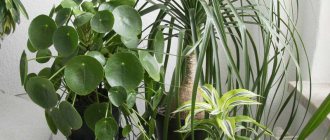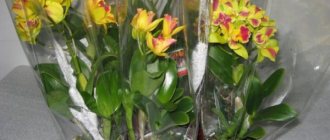Photo Nematanthus (Nematanthus) is an ornamental shrub from the Gesneriaceae family. The shoots of a young plant are directed upwards, in adulthood they become heavy and go down. In natural conditions, plants are common in the tropical zones of Colombia, Chile, Uruguay, and the homeland of the nematanthus is Brazil. A perennial plant develops quickly, the length of drooping shoots can reach at least 0.3 m.
It is not difficult to grow nematanthus subshrub at home. Blooms all summer, forming many small tubular flowers that look like goldfish. Previously, the genus Hypocyrtus and the genus Nematanthus were considered separate genera of the same family. According to the modern classification, they are combined, but sometimes nematanthus continues to be called hypocyrtus, although the name is considered outdated.
Be sure to pay attention to such wonderful plants as achimenes and columnea.
| Growth rate is high. |
| Blooms all summer, forming many small tubular flowers that look like goldfish |
| The plant is easy to grow. |
| It is a perennial plant. |
Nematantus (hypocyrta): harmonious appearance and homely character
Nematantus was born in the South American jungle, in the tropics of the Brazilian forests and Paraguay. In nature, these are semi-epiphytic plants, shrubs and vines. They settle on tree branches, on logs lying on the ground, in loose and light soil.
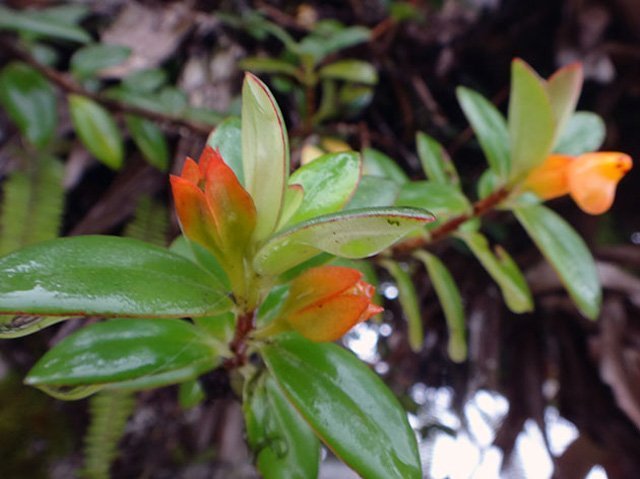
Nematantus is a tropical semi-epiphyte plant
Semi-epiphytes first develop above the ground, on a tree, like epiphytes. With age, they grow powerful hanging aerial roots that reach the ground and penetrate into it. This feature helps the semi-epiphyte plant to receive moisture and nutrition in any conditions.
The appearance of the nematanthus (hypocyrtus) is not quite typical for an epiphytic plant. Rather, it resembles a succulent. It has leathery, thick and shiny leaves, similar to boxwood, only larger. In some varieties of nematanthus (for example, in the coin), the leaves are covered with fine fine hairs. Interestingly, in partial shade, pubescence becomes more intense, and in bright sun it almost completely disappears. The foliage of the hypocyrte is often rich green above, and below it is reddish or purple in color. The color of the flowers includes different shades of yellow, orange-red and pink. There are plants with striped and speckled flowers. The petals are fused, so the inflorescence has an unusual shape - a jug or tubule with a swelling at the base, a narrow "neck" and bent edges. Thanks to this, the flower resembles a fish in shape. The nematanthus can bloom for up to four months in a row, from spring to autumn. If you arrange it with additional lighting, it will bloom in winter.
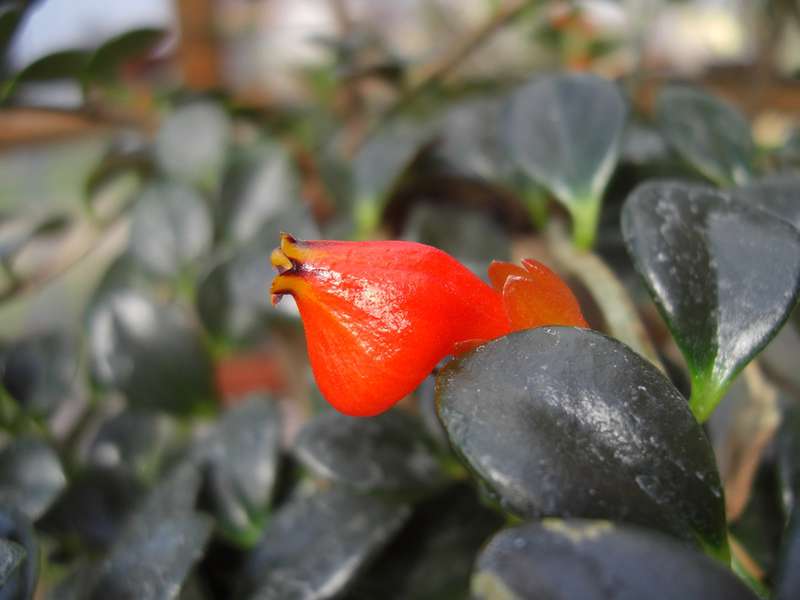

The nematanthus has thick leaves and very unusual fish flowers.
Previously, hypocyrtus and nematanthus were considered different plants, but with similar characteristics. In the current classification, they are assigned to the same genus, which is part of the Gesneriaceae family (Saintpaulia and Gloxinia are also included in it). Now these names have become synonymous. On sale you can find the same flowers under different names. The author of the name "nematanthus" is the German botanist and physician Heinrich Adolph von Schroeder. He combined two Greek words: mute - "thread" and tantus - "flower", got a flower on a thread.The plant got the name "hypocyrta" because of the flower of an unusual shape, translated from the Greek hypo - under, kyrtos - elongated.
As a houseplant, nematanthus has been cultivated since the mid-19th century. However, the plant has not yet gained very wide popularity. Florists fear that the exotic plant will be too difficult to care for. For abundant flowering, a hypocyrte requires a cool wintering, pruning is imperative and humidification of the air is required if it is very dry and hot. That's all the requirements. It's not that hard to do them. And the hypocyrta, the goldfish, will try to fulfill your desires: more bright greenery and longer flowering. In addition, new, less whimsical varieties of this wonderful plant are now appearing.


The compact flowering hypocyrte bush is very decorative
One of the important advantages of nematanthus is its naturally compact size. This flower usually does not grow more than half a meter. Bushy varieties are conveniently placed on the windowsill among other plants; ampelous forms do an excellent job of vertical gardening.
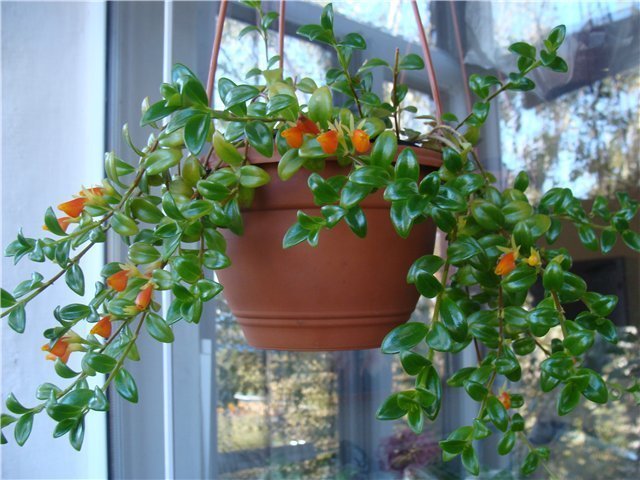

Ampel forms of nematanthus are grown in hanging pots
Skilled growers even grow bonsai from hypocyrtes. Nematanthus can also be used as a creeping plant in compositions with tall specimens. Its luscious greenery not only creates a pleasant background, but also decorates the room with fiery fish flowers or lingonberry berries, which fantasy tells someone.


Nematanthus bonsai looks original
And nematanthus multiplies without any problems. Fans of the fish flower admit that its stalk takes root easily both in soil and simply in water. And a young plant blooms at the age of one year.
Varieties and varieties of flower fish
The genus of nematanthus-hypocyrt has about 30 varieties. Only a few of them have taken root in home floriculture. The most popular are nematanthus naked and mint. The first is grown as a low shrub, the other as an ampel plant. Now you can buy variegated (with variegated foliage) varieties of hypocyrtes and fragrant ones. As flower growers assure, variegated nematanthus bloom even more willingly than their green relatives.
- Nematanthus glabrous, or glabrous hypocyrtus, is a semi-ample plant. Shoots, about 25 cm long, branch weakly. Leaves are elliptical, fleshy. Flowers of classic red-orange color.
- Riverine nematanthus is a liana with satiny large leaves, green above, reddish below. In their sinuses, thin peduncles with lemon flowers are formed.
- Nematantus Fritsch is a bush about half a meter high. Shoots pubescent, thin. The foliage is green-red, the flowers are pale pink, funnel-shaped, covered with fluff.
- Ankle nematanthus is an epiphyte dwarf shrub. Leaves are smooth, thick, light green. The flowers are solitary, with a characteristic swelling, red (up to 5 cm).
- Hypocyrta Vetstein is a plant with drooping, well-branching stems, in nature about 90 cm, grown as an ampelous plant. The leaves are small, oval-shaped. Flowers are small, just over 2 cm, orange-red-yellow. It blooms for a long time and actively.
- Coin nematanthus is an ampelous plant. The leaves are light green, round, dense, pubescent. The flowers are bright red with a yellow corolla. After flowering, it loses its foliage.
- Tropical nematanthus is distinguished by yellow-orange flowers with reddish-brown longitudinal stripes. Leaves are oval, pointed at the tip, dark green and shiny.
- Nematanthus gregarius is a plant with medium-sized leathery shiny leaves. Yellow-red flowers in shape and color are most similar to goldfish.
- Nematanthus gregarius Sarah is a variegated variety. Thick green leaves are decorated with a lighter green-yellow border.Flowers of a characteristic shape are red-orange with greenish-orange bracts.
- Nematantus Gregarius Golden West is another variegated plant. Leaves, dense with a waxy bloom, are green-blue in color, creamy yellow along the edge. The variegation of the leaves is emphasized by the red-orange "fishes" of flowers.
- Nematantus Santa Teresa or albus is a rare variety with white and fluffy speckled flowers. They are not only good-looking, but also have a pleasant citrus-olive scent.
Photo gallery: varieties and varieties of nematanthus (hypocyrtes)


Nematantus Fritsch
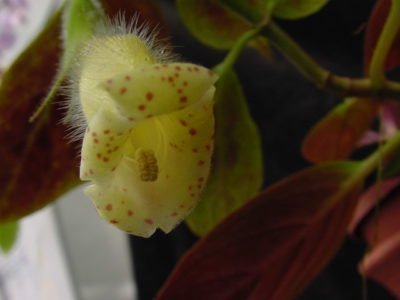

Nematantus Santa Teresa or albus
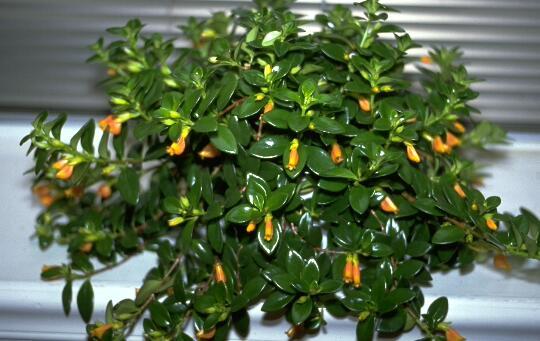

Hypocirt Wetstein
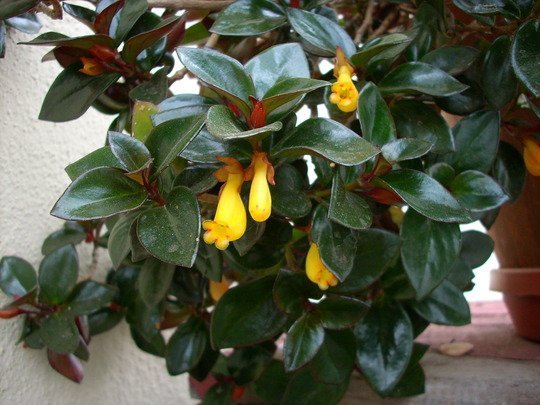

Riverine nematantus
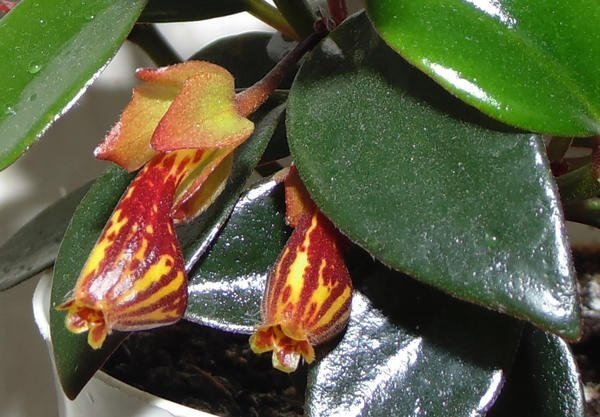

Nematanthus tropical
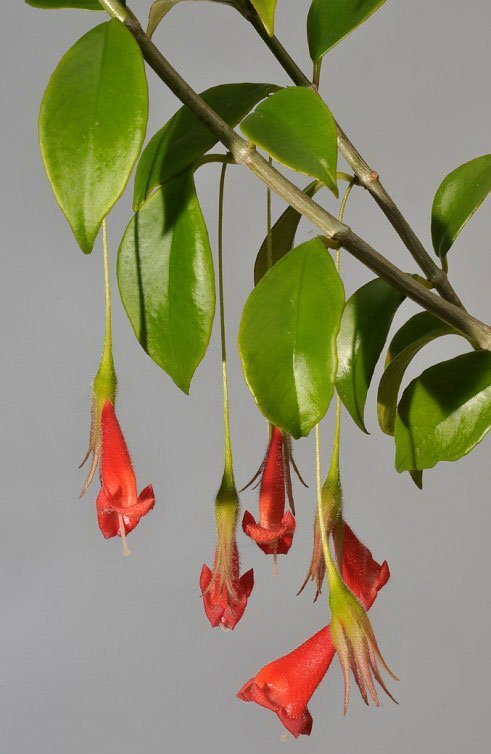

Nematanthus ankle
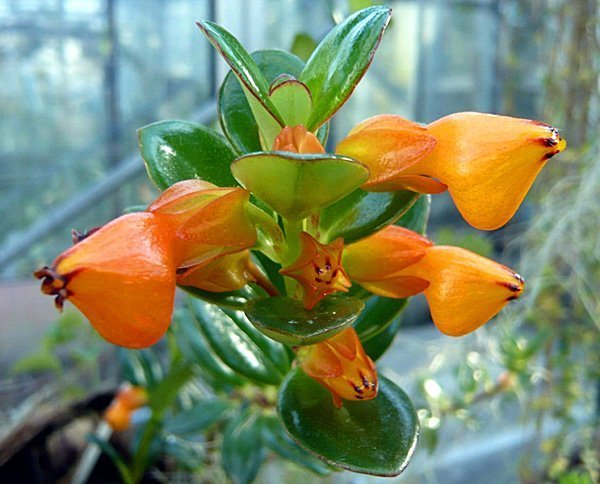

Nematantus naked
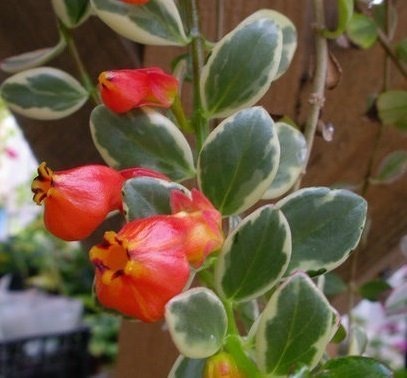

Nematantus Gregarius Golden West
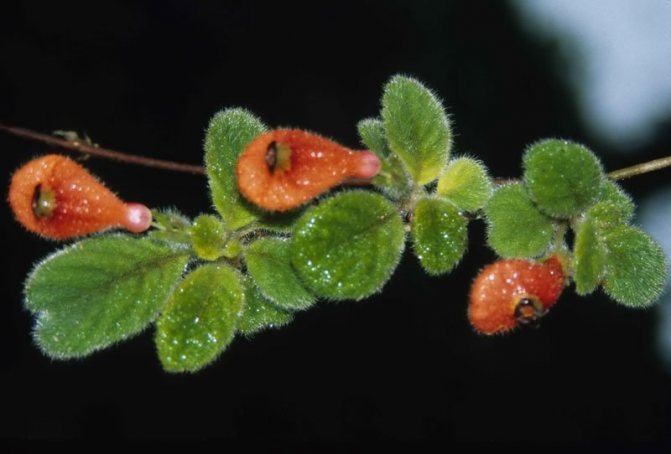

Nematanthus coin
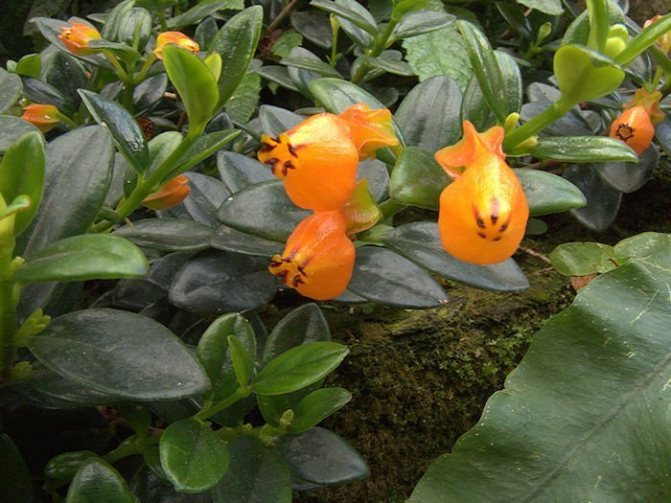

Nematantus gregarius
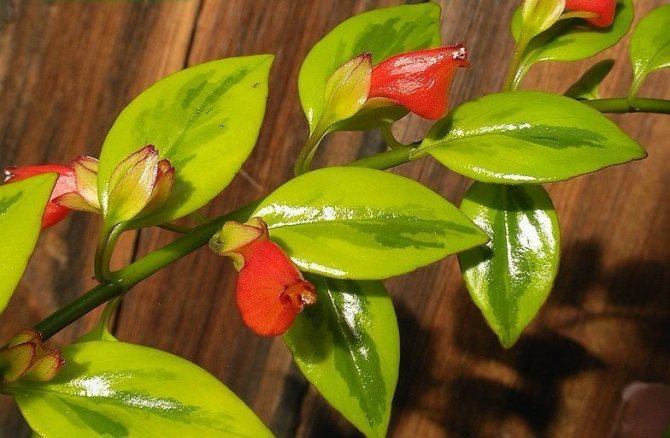

Nematantus Gregarius Sarah
General description with photo
A more accurate systematization of hypocyrtes was made by Professor Schrader, who included this South American culture in the genus Nematantus, abolishing the genus of the same name. Its species diversity includes epiphytes, and semi-epiphytic vines, and even shrubs with semi-shrubs.
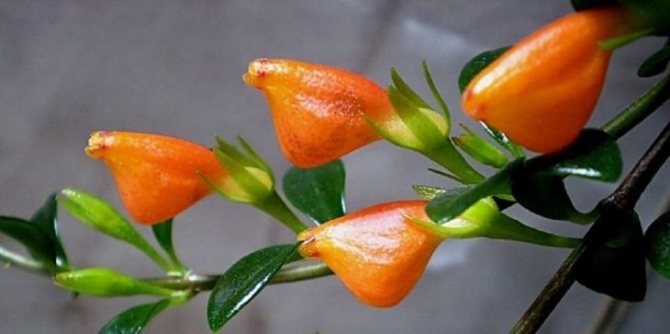

The leaf plate of the hypocyrte is round, short, obovate, with a slight sharpening. The surface of the leaf is often smooth, glossy, but there are species with pubescence. On the back, the leaf has a lilac tint. Flowering occurs in early summer, buds are formed at the base of the leaf, in the axils. The formed flower has an asymmetrical shape with a significant downward bend. Erect species grow up to 50-60 cm, and those that give creeping vines usually do not rise higher than 10-15 cm.
Conditions for plants, goldfish
Nematantus is a light and moisture-loving plant. But light and moisture are necessary for this flower in each season in different quantities. In winter, more light is required and less humidity. And in summer, goldfish need to be shaded from the sultry sun, but surrounded by a humid atmosphere. And the comfortable temperature for nematanthus varies greatly. More details about the conditions of keeping this semi-epiphyte are in the table.
Table: conditions for hypocyrt
| Spring | Lighting - bright diffused light, slight partial shade is acceptable. Buds will not be laid without good lighting. Southeast and southwest are suitable for placement of nematanthus. West and East directions are fine too. There will be little light in the north. In the south, you will have to shade. Humidity is moderate, 50-60%. The temperature is moderate and slightly higher, 20-25 degrees. Loves fresh air, ventilate the room. |
| Summer | For the summer, a pot of nematanthus can be sent to a protected balcony or veranda. Lighting is bright light. It is necessary to shade from the hot sun at noon. In the heat, spray the air around the plant, this is useful for high-quality flowering. But do not let water get on the buds and flowers. The temperature is quite high, 25 degrees and even more. It is not afraid of changes in night and daytime temperatures. |
| Fall | Bring the nematantus home as soon as the average daily temperature drops to + 18. Lighting - bright diffused light, maybe a little direct sun. Humidity is moderate, 50-60%. Temperature 20-25 degrees. By the end of autumn - plus 16-18 degrees. |
| Winter | Lighting - bright light, small amount of direct sun. Can be placed in the south. If there is little light, the stems are too elongated, the leaves become smaller. Arrange artificial lighting. Daylight hours should last at least 12 hours. Humidity is moderate, 50-60 percent. Spray the air around the plant occasionally. Especially when kept warm. The lower the temperature, the less humidity should be. And vice versa. The temperature is cool, plus 16-18 degrees. It can be lower (up to +14), but then no water procedures and irrigation. |
When buying nematanthus, find out what humidity is required for this species.Some hybrid varieties are comfortable with dry air. For them, do not specifically moisturize it. And the original forms are more demanding on humidity, especially in the hot season.
Video: nematanthus (hypocyrta) - conditions and care
Main types
Hypocyrta is presented in many different types.
Some of them are ideal for growing at home:
- hypocyrt coin Is an unusual species with creeping stems. A distinctive feature of this variety is the fluff that covers the rounded leaves of the plant. The length of the shoots does not exceed 15 cm, the flowers are glossy, orange-red. For the winter, this variety sheds foliage;
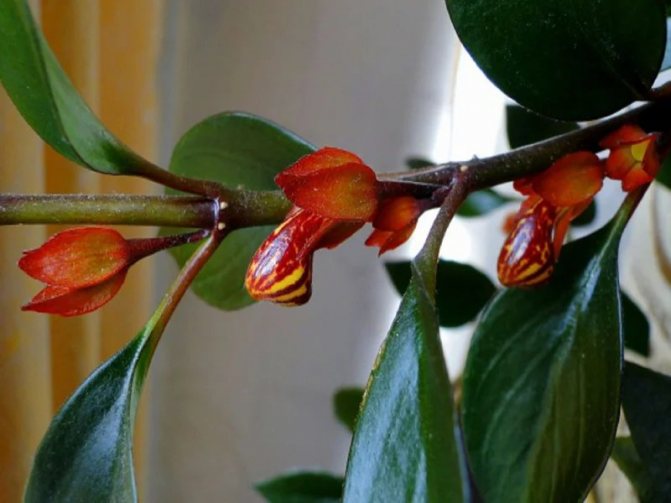

- Glabra - is a small shrub with upright dense stems covered with glossy small elongated leaves - dark green above and lighter below. The height of the shoots is about 50-60 cm, at the base of the leaves are orange-colored buds - in groups of 2-3 pieces;
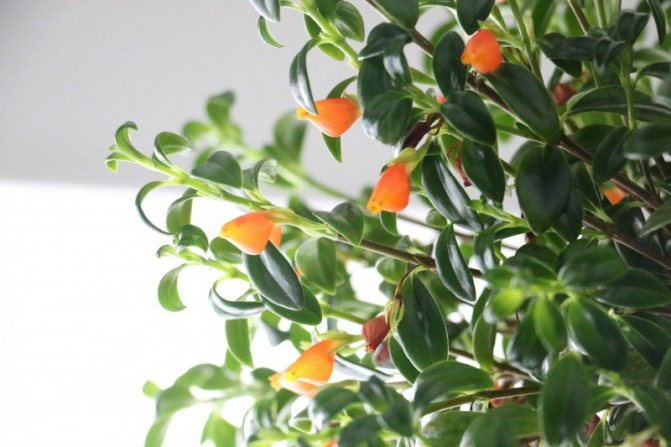

- Tropicana - a magnificent view with diamond-shaped glossy leaves of dark green color. Stems are tall, straight. The flowering of the variety is abundant, lasts all summer. The flowers are yellow, along the bud there are dark orange stripes;
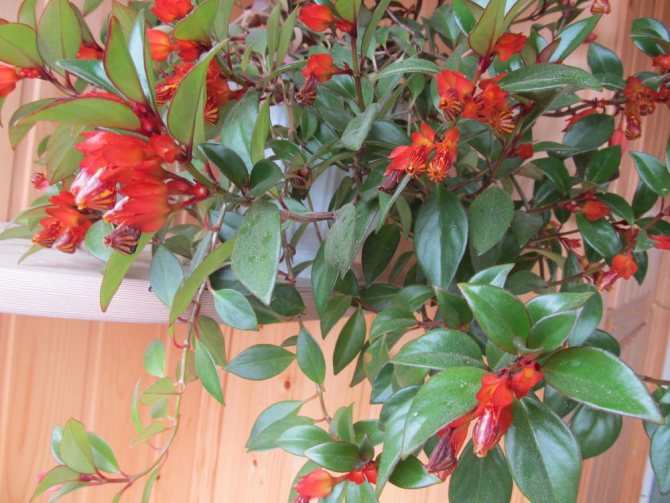

- Gregarius - is an ampelous plant with low creeping stems. The leaves are small, shiny, densely located on the shoot; have an elongated, slightly pointed shape. The culture blooms with small tubular flowers (depending on the variety, red or yellow);
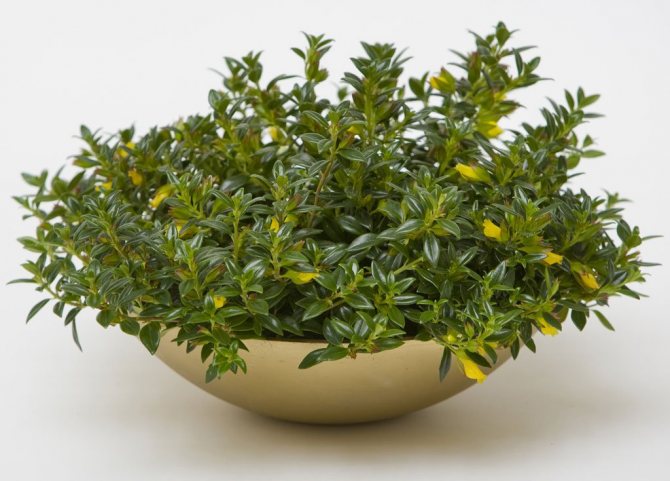

- Columney's nematanthus - the brightest representative of this species. The stems are half erect, about 30–40 cm long, the foliage is large, green, pointed, with deep veins. The flowers are large, tubular, scarlet. This variety is singled out as a separate genus due to a number of external differences from the classical representatives of the nematanthus;
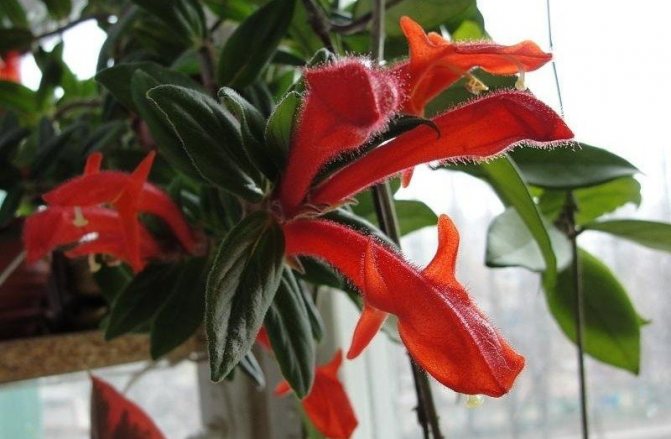

- Variegated - got its name due to the unusual color of the foliage: small, waxy leaves in the center are painted in a dark green color, and have a light green edging around the edges. Sometimes there is another option - light leaves with dark "tan" along the edge. The flowers are orange in standard form.
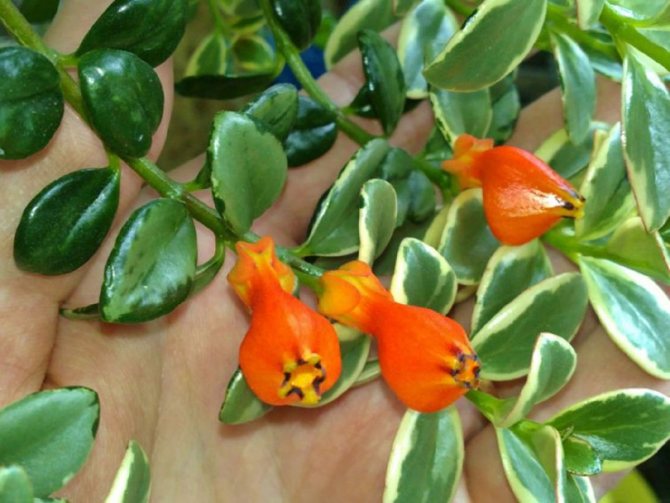

Infrequent transplant, small pot
Nematanthus does not grow very quickly, in this it also looks like a succulent. It builds up the aboveground part rather slowly and the underground part even more slowly. Therefore, the plant does not need frequent transplantation. Even young nematanthuses are transplanted, or rather transplanted, every 2-3 years. By the way, a cramped pot is an incentive for the formation of buds. The flower will signal that it is time to start the transplant itself. Growth from above will be more modest and roots will appear in the drainage holes. As a rule, the procedure is carried out in early spring, when the plant is just starting to grow.
The new container for nematanthus should not be too spacious, only 2-3 cm larger than the old one. Otherwise, it will not bloom. In addition, a large pot increases the risk of putrefactive diseases. In a large volume of land, moisture stagnates longer, parasites settle. And the very delicate root of the nematanthus can get sick.
Prepare the soil for nematanthus loose and airy, slightly acidic or neutral. Approximate composition options:
- ready-made soil for Saintpaulias;
- leafy earth, peat and sand in equal proportions, add chopped pine bark or chopped moss for looseness;
- a mixture of two shares of leafy earth and one at a time - humus, peat and sand with the addition of charcoal crumbs.
High-quality drainage is required for nematanthus (expanded clay, brick chips, vermiculite, pebbles), it will help prevent stagnation of moisture at the roots. How to transplant a fish plant?
- Take a suitable container with large holes, place a drainage layer on the bottom. Everything must be disinfected, boiled, or at least doused with boiling water.
- Spread the sterilized primer on top.Don't tamp it too hard, it should keep it airy.
- Remove the nematanthus from the old pot, being careful to keep the earthy ball. Handle roots very carefully.
- Protect healthy roots, even small ones, from injury, they do not need to be pruned. The root system of the nematanthus grows slowly.
- Place the earthen nematanthus ball in a new pot. Sprinkle the earth. Lightly tamp the substrate at the roots. Leave the soil loose.
- After transplanting, water the plant with warm water, you can spray it.
- Place the transplanted nematanthus in its permanent location.
For information on how to properly root a hypocyrte stalk and control its survival rate, read the chapter "Reproduction of a fish plant".
Caring for nematanthus at home
Nematanthus is not one of those plants that can be forgotten. This tropical flower does not forgive neglect, but readily responds to care. So, if you do not forget to water and feed the nemantanthus, cut its stems in time, expect a large offspring of goldfish. A well-groomed plant can bloom up to 4 months a year.
Watering and feeding
During growth and flowering (in spring, summer and early autumn), the nematanthus is watered generously, not allowing the soil to dry out. It should always be slightly damp, only the top layer can dry out. With a lack of water, small leaves can dry out and fall off, and large ones curl up. In winter, watering is reduced to moderate. If wintering is at high temperatures, water more. In a cool room (about +12), you can switch to an almost dry mode. Wet feet and cold air are a sure way to root rot or other ailments. Increase watering gradually in the spring.
If you've given the nematanthus a dry spell and is already losing leaves, try correcting the oversight. Submerge the pot with the plant in a large container of water halfway. Wait until the soil is saturated with moisture, take out the pot and fill in fresh substrate between the walls and a lump of earth.
Irrigation water for a delicate tropical plant needs lukewarm and soft: rain, melt, settled or filtered. Water the nematanthus carefully, under the root, it does not like water getting on the leaves.
Top dressing of nematanthus during the period of growing greenery and flowering is given once every two weeks or a little more often (but not more than three times a month), and in winter it is completely stopped. Mineral complexes for flowering crops are suitable. Pay attention to the content of potassium and phosphorus, these elements are especially beneficial for nematanthus. Prepare the fertilizer solution according to the instructions, slightly reducing the dose. And before feeding, be sure to water the plant, the fertilizer can burn its delicate roots.
Blooming: why aren't goldfish appearing?
Healthy and well-groomed nematanthus blooms for a long time. The first fish buds may appear in March, and the last ones in November. Those who have been breeding this plant for a long time claim that with additional illumination in winter, the nematanthus will continue to bloom. But then there is a danger that the plant will drain its strength.
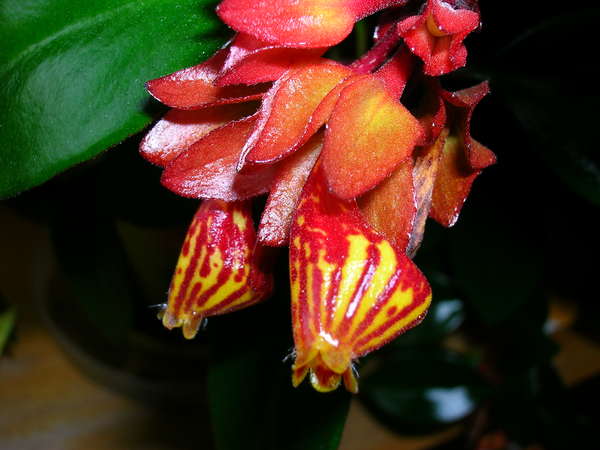

Good maintenance, cool winter rest and pruning are the ingredients of long-lasting flowering.
But it happens that the nematanthus does not bloom in any way. Most likely, the conditions of detention or the rules of care were violated. Why don't goldfish appear?
- Too voluminous pot. For flowering, the roots of the nematanthus must be cramped.
- There is not enough light, the buds are laid in bright, but diffused lighting.
- In the previous season, the nematanthus was not watered or fertilized much, it is depleted.
- The plant has not been pruned. Remember: nematanthus buds are laid only on young shoots.
- The plant did not rest in winter and did not accumulate strength during the dormant period.
Pruning and dormant time
Nematanthus should be cut off annually, without this you will not achieve rapid flowering.Most often, pruning is done in the fall immediately after the plant has faded and begins to retire. However, during warm wintering, pruning can be postponed until spring. This procedure gives a sanitary and rejuvenating effect. First of all, weakened and thinned shoots are removed. But even quite healthy stems should be cut off in order to stimulate the formation of branches and flowering. Young ones are shortened by a third, and old ones by half their length. Cut shoots can be used for propagation. Sometimes the plant has to be cut twice: in the fall and on the eve of spring. It depends on how the nematanthus spent the rest period.
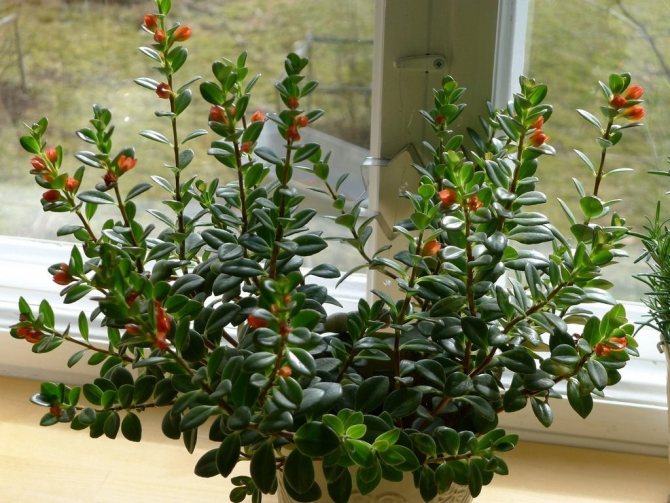

Nematanthus is regularly pruned to form a bush and achieve abundant flowering.
So, your nematanthus has bloomed safely, you have cut off unnecessary stems - now is the time to send the plant to rest. The best rest for a fish flower is a cool (+ 12-18 degrees) and well-lit room (ideally with artificial lighting), very limited watering and no feeding. If the temperature is low, the flower will not need to be sprayed. Such a cool and hungry wintering will be the best stimulus for blossoming in spring.
Table: growing hypocyrtes at home - care errors
| Manifestation | Cause | Elimination |
| Nematanthus sheds leaves and buds. |
|
|
| The leaves lose color, turn yellow, the edges curl up. | Too much direct sun. | Shade nematanthus on clear days. Place at some distance from the window. |
| Brown spots on leaves after spraying. | Burns. | In summer, spray the plant early in the morning or evening, but not at noon. Do not leave the sprayed flower in direct sunlight. |
| The plant withers, the reasons are not visible. | An excess of mineral fertilizers in the soil. | Do not feed nematanthus more than once every 10 days. Be sure to water the plant before feeding and follow the fertilizer dosage. |
| Nematantus blooms sluggishly or does not bloom at all. | Little light, little power, very dry or cold air. No trimming done. | Observe the peculiarities of caring for the plant and create a comfortable environment. |
| The edges of the leaves dry up and turn yellow. | Hot and dry air. | Keep humidity higher when kept warm. Place a vessel with water next to it, a tray with wet pebbles, and freshen the air and the plant. |
| The buds and flowers turn brown and fall off. | When spraying or watering, large drops hit the flowers. | Use a fine spray, try to keep the water out of the flowers and buds. |
| Dimples appeared in the pulp of the leaves. | Violation of the watering regime. At first, the plant was overdried, and then flooded. | Adjust your watering schedule. |
Video: caring for hypocyrtus (nematanthus) and other gesnerian plants
Temperature
The nematanthus flower requires a certain temperature regime. In winter, the desired air temperature for nematanthus is +15.
Maintaining a stable temperature during the cold season is very important. Long exposure to warmer environments results in slow growth in summer and no flowering.
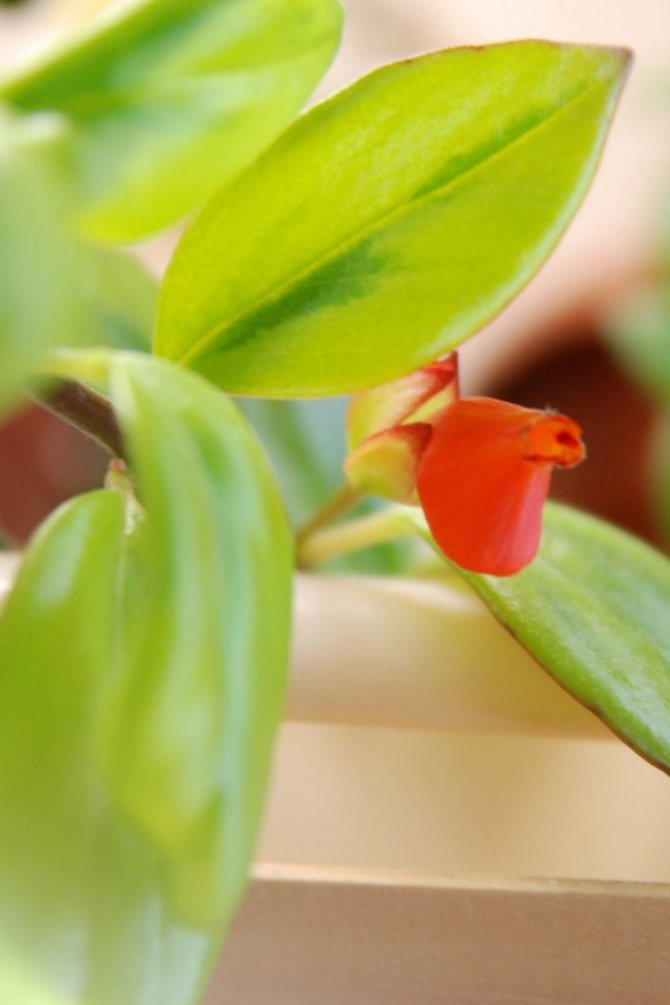

Diseases and pests
With quality care, the nematanthus will be strong and healthy. But in case of violations of the irrigation regime or the conditions of maintenance, the plant can get sick, it is threatened by various types of rot and powdery mildew. A weakened flower is an easy prey for parasites. Thick and appetizing nematanthus leaves are ready to feast on aphids, thrips, mealybugs or spider mites. How to resist ailments and parasites - about this in the table.
Table: diseases and parasites of nematanthus
| Manifestation | Disease or pest | Treatment, prevention |
| White, damp, cotton-like lumps on leaves and stems. After a while, the leaves wither and die. | Mealybug lesion. | Remove the pest by hand with a cloth soaked in alcohol solution. Process the plant |
| The leaves are covered with light yellow spots, sometimes a cobweb is visible. | Spider mite is a small insect that lives on the underside of leaves, feeds on their juice. | Spray nematanthus with a systemic insecticide (Actellik, Kleschevit, Fitoverm). |
| Young shoots and buds curl and dry up, tiny insects are visible. | Defeat by aphids. | Treat the plant with specialized aphids (Antitlin, Biotlin), preparations containing permethrin. |
| Plant growth has slowed down, flowers are deformed. Silvery streaks on the leaves. | The plant is attacked by thrips, black flying insects. | At the first sign, treat the plant with an insecticide (Akarin, Aktellik, Fitoverm) |
| A gray, fluffy mold has appeared on the plant. | Gray mold caused by fungus. | Remove affected parts, change moldy soil. Treat with a fungicide (Fundazol). Reduce watering, do not spray, ventilate the room. Prevention: Avoid high humidity in a cool room. |
| The leaves wither en masse, but do not dry, then turn yellow and die. | The root system is affected by rot caused by the fungus. | Need quick help. Remove the plant from the pot, assess the degree of damage. All roots are softened and darkened: it is too late to heal. The main part of the root system retains its elasticity: the plant is treatable. Carefully remove areas that are affected by rot, dry, transplant the plant into a new pot and sterilized substrate, pour with a solution of carbendazim. Prevention: plant the plant in a sterilized pot and substrate, provide high-quality drainage, do not allow moisture to stagnate at the roots, especially at low temperatures. |
| White powdery coating on leaves or stems. | Powdery mildew. | If the damage is minor, remove the stains by hand. If the leaf is severely affected, remove it entirely. Treat the plant with Fitosporin-M or sulfur. For prophylaxis, regularly ventilate the room. Fresh air helps to avoid illness. |
Reproduction of nematanthus at home
You can grow a new nematanthus from seeds and cuttings. Sowing seeds is a long and troublesome business, but sometimes this is the only way to get exactly the plant you want. Cutting nematanthus is an easy task. Growers often share their propagation success by cuttings. According to them, the survival rate with this method is one hundred percent. The cuttings are rooted in soil, sand, live sphagnum moss or simply in water. And this can be done almost all year round, combining with plant pruning.
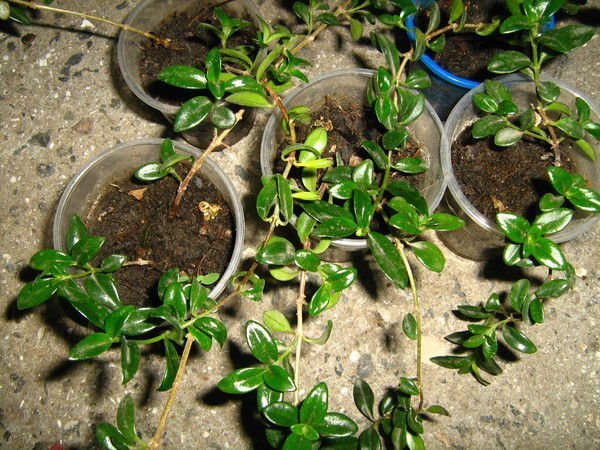

Almost one hundred percent of nematanthus cuttings take root
Propagated by cuttings
- Cut the top cuttings from adult stems, there should be 4 - 5 nodes, buds and flowers are not needed.
- Remove two leaves from the bottom of the cuttings. Treat the bottom with phytohormone (Zircon, Epin), place in the solution by 1 cm, hold for a few seconds.
- Fill the container with wet peat in half with sand.
- Plant the cuttings in the substrate so that the knot is under the ground, roots will form there. Spray the seedlings with water, cover with foil or a transparent lid.
- Place in a bright and warm (+ 22–25) place.
- Moisten by spraying, ventilate the plantings.
- Rooting takes 2-3 weeks.
- Rooted cuttings are transplanted into small (7–10 cm) pots of several pieces.
Young green shoots of nematanthus are not suitable for grafting, they root poorly and are more prone to rot.
Propagated by seeds
- Shake out small seeds from ripe pods onto a sheet of paper.
- Prepare a container with drainage holes and a sowing tray, fill it with peat and sand subtrate, moisten it.
- Spread the seeds carefully over the substrate, cover with glass, plastic or a transparent lid.
- Water crops through the pallet, ventilate occasionally.
- When sprouts appear, remove the shelter.
- Gently moisten the seedlings, cut them out after two weeks.
- Grown up young nematanthuses are planted in several specimens in one pot. They should bloom next year.
Nematantus is not the easiest plant to care for. It won't wait patiently like a dour cactus when you think of watering. But is it really bad to have someone you need to constantly take care of? This is especially important for children, entrust them with caring for the nematanthus. Since childhood, have you dreamed of an aquarium with fish, but never got one? Treat yourself to interacting with Nematanthus goldfish. They are still more viable than the real ones. And you can surprise your guests with such an original "aquarium". In addition, the dense leaves of nematanthus clean the air well. And there is a belief that his goldfish bring success and happiness to their owner.

